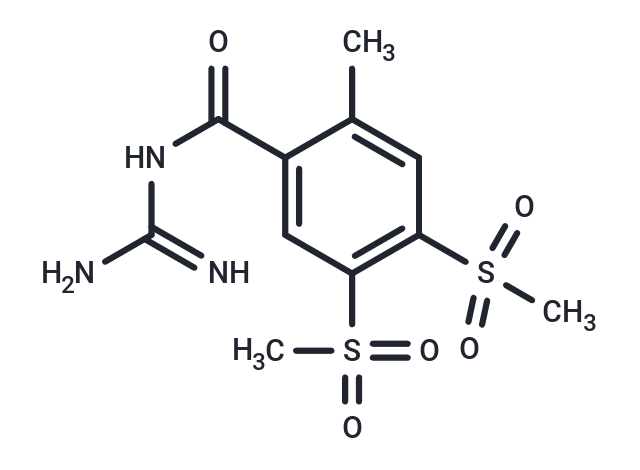Shopping Cart
- Remove All
 Your shopping cart is currently empty
Your shopping cart is currently empty

Rimeporide (EMD-87580) (EMD-87580) is a potent and selective Sodium hydrogen exchange 1 (NHE-1) inhibitor.

| Pack Size | Price | Availability | Quantity |
|---|---|---|---|
| 1 mg | $40 | In Stock | |
| 2 mg | $59 | In Stock | |
| 5 mg | $97 | In Stock | |
| 10 mg | $178 | In Stock | |
| 25 mg | $397 | In Stock | |
| 50 mg | $582 | In Stock | |
| 100 mg | $829 | In Stock | |
| 1 mL x 10 mM (in DMSO) | $116 | In Stock |
| Description | Rimeporide (EMD-87580) (EMD-87580) is a potent and selective Sodium hydrogen exchange 1 (NHE-1) inhibitor. |
| In vitro | Treatment for 24 h with 10 μM phenylephrine significantly increased cell surface area to 129.6 3.1% of control values. The hypertrophic effect of phenylephrine was completely abrogated by 5 μM of EMD87580 [1]. |
| Cell Research | To induce hypertrophy, myocytes were treated for 10 min or 24 h as appropriate and noted under Results with 10 μM phenylephrine in the absence or presence of the following agents: the NHE-1 inhibitor EMD87580 (5 μM) or cariporide (5 μM), the JNK1/2 inhibitor SP600125, the p38 inhibitor SB203580, the ERK1/2 inhibitor PD98059 (all at 10 μM), and the reverse mode Na+-Ca2+ exchange inhibitor KB-R7943 or SN-6 (both at 10 μM). All drugs were added 30 min before the addition of phenylephrine [1]. |
| Animal Research | Two groups were studied. The treatment group (n = 5) received EMD 87580 at a dose of 5 mg/kg IV bolus 5 min before aortic cross-clamping and 10 mol/L EMD 87580 in the cardioplegic solution. The control group (n = 9) received the same volume of saline vehicle. Systemic pretreatment was used to ensure drug availability during the ischemic period prior to CPA. Direct infusion via cardioplegia ensures drug delivery at the time of ischemia (CPA), and it decreases the variability of drug delivery that may occur during the hemodilution with CPB initiation. Incorporation into the cardioplegia also minimizes the potential variable of drug/extracorporeal circuit interactions. Using this dosing regimen, the plasma concentration of EMD 87580 was in the 2,500 to 3,000 ng/mL range at 10 min after CPB. This concentration has been shown to be effective at Na+/H+ exchanger inhibition in vitro [2]. |
| Alias | EMD-87580 |
| Molecular Weight | 333.38 |
| Formula | C11H15N3O5S2 |
| Cas No. | 187870-78-6 |
| Smiles | Cc1cc(c(cc1C(=O)NC(N)=N)S(C)(=O)=O)S(C)(=O)=O |
| Relative Density. | 1.55 g/cm3 (Predicted) |
| Storage | Powder: -20°C for 3 years | In solvent: -80°C for 1 year | Shipping with blue ice. | ||||||||||||||||||||||||||||||
| Solubility Information | DMSO: 15 mg/mL (50 mM) | ||||||||||||||||||||||||||||||
Solution Preparation Table | |||||||||||||||||||||||||||||||
DMSO
| |||||||||||||||||||||||||||||||

Copyright © 2015-2024 TargetMol Chemicals Inc. All Rights Reserved.